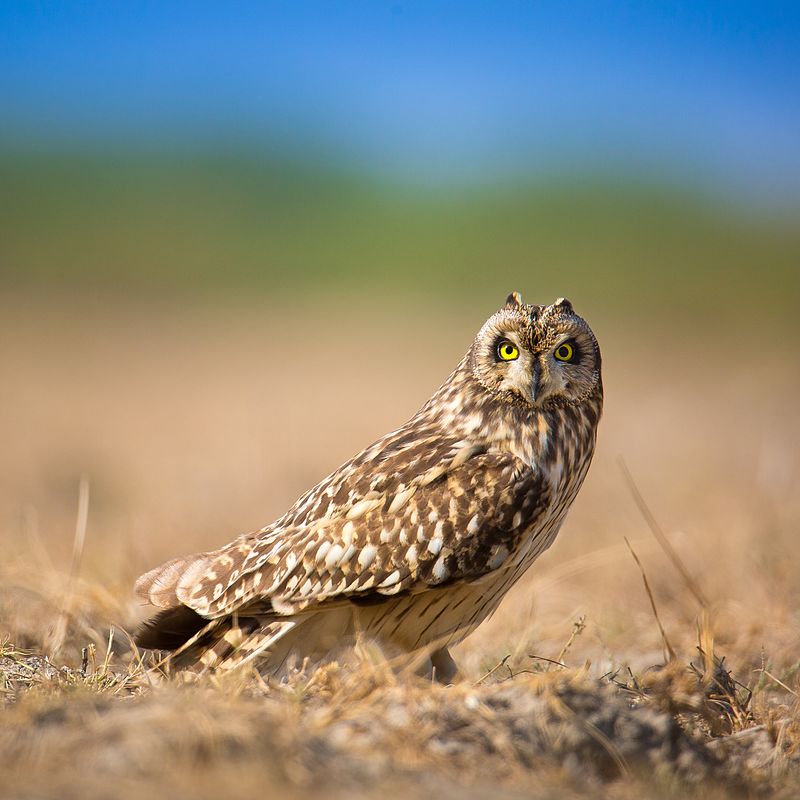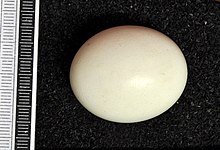
Description
The short-eared owl is a medium-sized owl measuring 34–43 cm (13–17 in) in length and weighing 206–475 g (7.3–16.8 oz).[3] It has large eyes, a big head, a short neck, and broad wings. Its bill is short, strong, hooked and black. Its plumage is mottled tawny to brown with a barred tail and wings. The upper breast is significantly streaked.[4] Its flight is characteristically floppy due to its irregular wingbeats. The short-eared owl may also be described as "moth or bat-like" in flight.[5] Wingspans range from 85 to 110 cm (33 to 43 in).[6] Females are slightly larger than males. The yellow-orange eyes of A. flammeus are exaggerated by black rings encircling each eye, giving the appearance of them wearing mascara, and large, whitish disks of plumage surrounding the eyes like a mask.Separation from long-eared owl
Over much of its range, short-eared owls occurs with the similar-looking long-eared owl. At rest, the ear-tufts of long-eared owl serve to easily distinguish the two (although long-eared owls can sometimes hold its ear-tufts flat). The iris-colour differs: yellow in short-eared, and orange in long-eared, and the black surrounding the eyes is vertical on long-eared, and horizontal on short-eared. Overall the short-eared tends to be a paler, sandier bird than the long-eared. There are a number of other ways in which the two species the differ which are best seen when they are flying: a) short-eared often has a broad white band along the rear edge of the wing, which is not shown by long-eared; b) on the upperwing, short-eared owls' primary-patches are usually paler and more obvious; c) the band on the upper side of short-eared owl's tail are usually bolder than those of long-eared; d) short-eared's innermost secondaries are often dark-marked, contrasting with the rest of the underwing; e) the long-eared owl has streaking throughout its underparts whereas on short-eared the streaking ends at the breast; f) the dark markings on the underside of the tips of the longest primaries are bolder on short-eared owl; g) the upperparts are coarsely blotched, whereas on long-eared they are more finely marked. The short-eared owl also differs structurally from the long-eared, having longer, slimmer wings: the long-eared owl has wings shaped more like those of a tawny owl.[7] The long-eared owl generally has different habitat preferences from the short-eared, most often being found concealed in areas with dense wooded thickets. The short-eared owl is often most regularly seen flying about in early morning or late day as it hunts over open habitats.Subspecies
On the Galapagos Islands, Ecuador
- A. f. bogotensis – Chapman, 1915: found in Colombia, Ecuador and northwestern Peru
- A. f. domingensis – (Statius Müller, 1776): found on Hispaniola
- A. f. flammeus – (Pontoppidan, 1763): nominate, found in North America, Europe, northern Africa and northern Asia
- A. f. galapagoensis – (Gould, 1837): Galápagos Islands[10]
- A. f. pallidicaudus – Friedmann, 1949: found in Venezuela, Guyana and Suriname
- A. f. ponapensis – Mayr, 1933: found on east Caroline Island
- A. f. portoricensis – Ridgway, 1882: found in Puerto Rico
- A. f. sandwichensis – (A. Bloxam, 1827): Pueo or Hawaiian short-eared owl - found in the Hawaiian Islands[11]
- A. f. sanfordi – Bangs, 1919: found on the Falkland Islands
- A. f. suinda – (Vieillot, 1817): found from southern Peru and southern Brazil to Tierra del Fuego
- A. f. cubensis – Garrido, 2007: found in Cuba
Range
The short-eared owl occurs on all continents except Antarctica and Australia; thus it has one of the most widespread distributions of any bird. A. flammeus breeds in Europe, Asia, North and South America, the Caribbean, Hawaii and the Galápagos Islands. It is partially migratory, moving south in winter from the northern parts of its range. The short-eared owl is known to relocate to areas of higher rodent populations.[12] It will also wander nomadically in search of better food supplies during years when vole populations are low. (See a map of the short-eared owl's distribution across the New World.)| Full list of countries where Asio flammeus is found[1] |
|---|
Behaviour
Short Eared Owl in its habitat. Notice how it chooses short shady trees to roost under, in a grassland/ desert habitat.
Nesting and reproduction
Egg, Collection Museum Wiesbaden
The short-eared owl nests on the ground in prairie, tundra, savanna, or meadow habitats. Nests are concealed by low vegetation, and may be lightly lined by weeds, grass, or feathers.[12] Approximately 4 to 7 white eggs are found in a typical clutch, but clutch size can reach up to a dozen eggs in years when voles are abundant. There is one brood per year. The eggs are incubated mostly by the female for 21–37 days. Offspring fledge at a little over four weeks. This owl is known to lure predators away from its nest by appearing to have a crippled wing.[4]
Diet and foraging habits
In flight
In flight
In Piraju, São Paulo, Brazil
Pellets
Because of the high pH in the stomach of owls they have a reduced ability to digest bone and other hard parts, they eject pellets containing the remains of their prey.[16]Calls
Short-eared owls have a scratchy bark-like call. Raspy waowk, waowk, waowk or toot-toot-toot-toot-toot sounds are common. A loud eeee-yerp is also heard on breeding grounds. However, short-eared owls are silent on the wintering grounds.[4]Conservation status
The examples and perspective in this article may not represent a worldwide view of the subject. (December 2010) (Learn how and when to remove this template message)
|
It is listed as endangered in New Mexico. Its appearance at the Calverton Executive Airpark on Long Island has prompted the New York State Department of Environmental Conservation to take the lead on ruling whether a massive redevelopment of the airport will receive the necessary environmental permits.[3]

Synonym
- Asio accipitrinus (Pallas, 1771)
- Strix accipitrina Pallas, 1771
- Strix flammea Pontoppidan, 1763






No comments:
Post a Comment
Note: Only a member of this blog may post a comment.